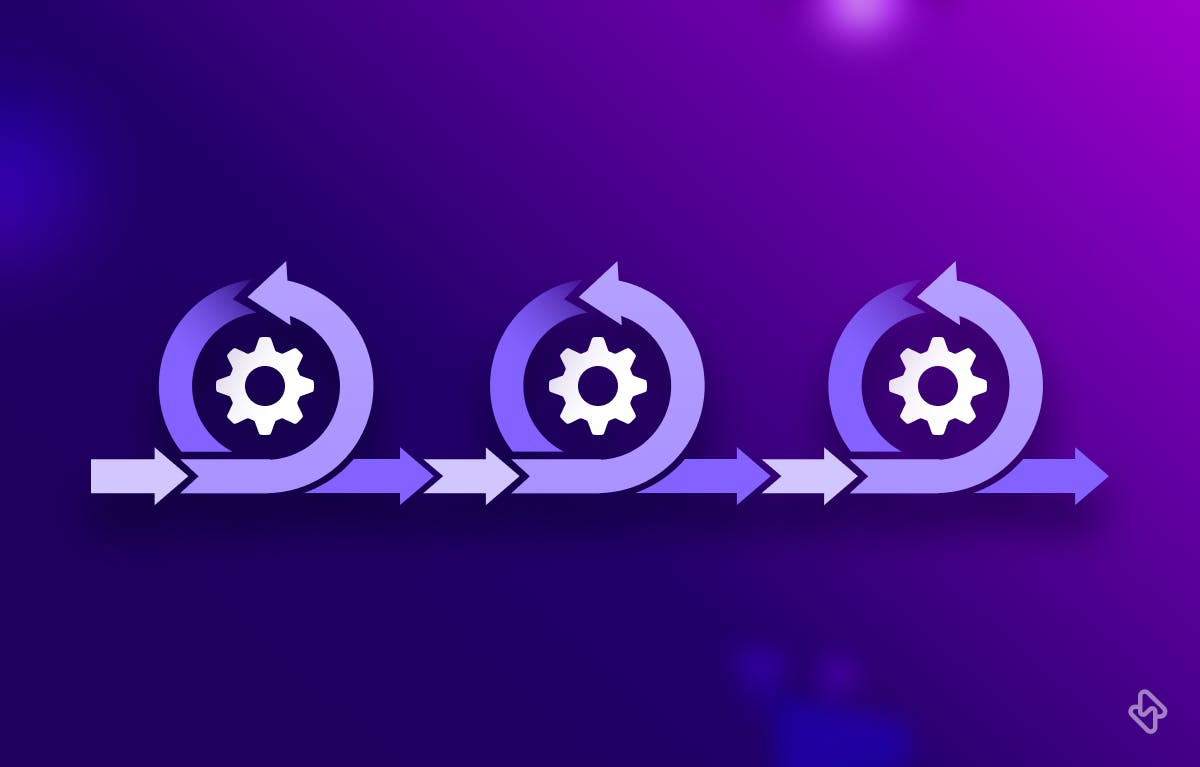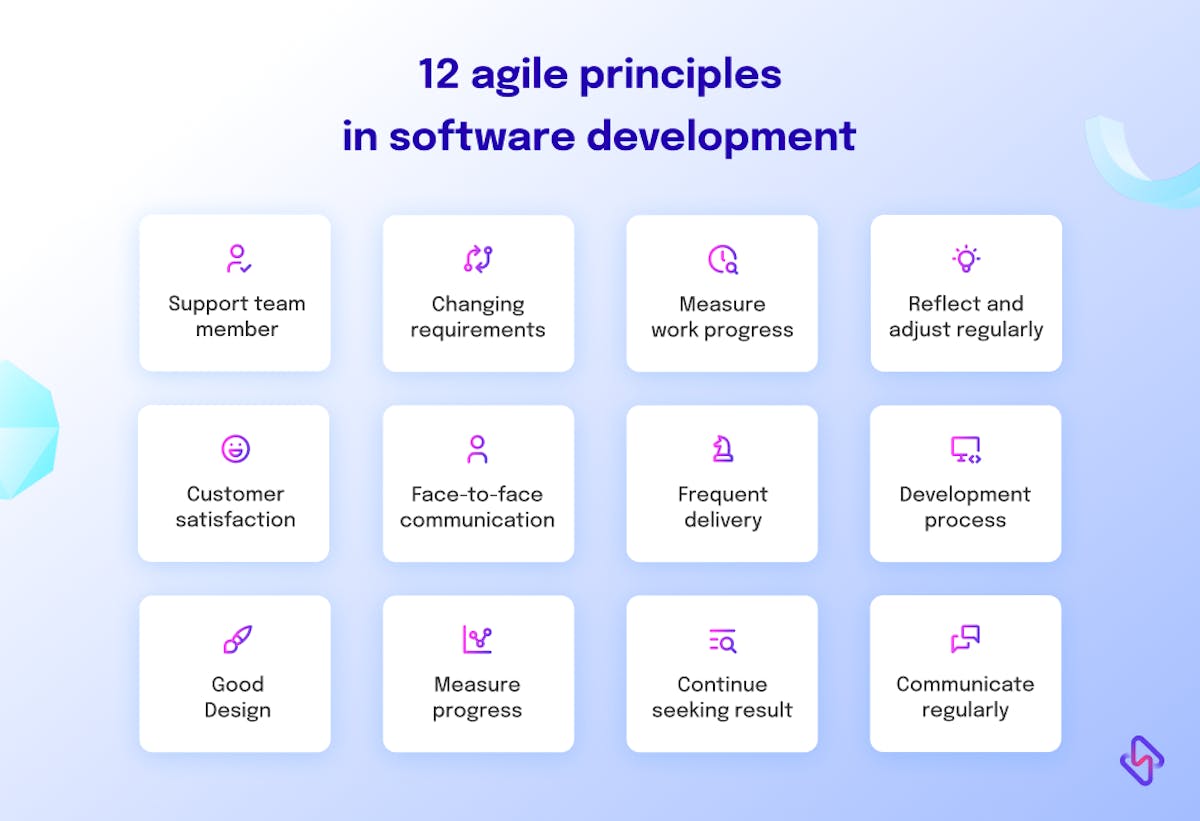1. Continuous value delivery
“Our highest priority is to satisfy the customer through early and continuous delivery of valuable software”
The probability of selling to an existing customer is between 60% - 70%. But only 18% of companies prioritize customer retention. In the software industry, an easy way to delight customers is to continuously satiate their hunger for more features, functionalities, and improved customer experience. All this is achievable with the first agile principle that suggests imbibing continuous delivery into your software development lifecycle.
- Modern IT practices like DevOps have this as their core soul.
- Continuous delivery preps you to quickly adapt to evolving market conditions, and customer needs, and inject continuous feedback into your development lifecycle.
- This results in better quality software, boosts customer satisfaction, builds trust & loyalty, improves engagement, and influences repeat businesses.
[Read: Agile Software Development- Deliver Delightful Products]
2. Embrace changing requirements
“Welcome changing requirements, even late in development. Agile processes harness change for the customer's competitive advantage.”
Another channel to improve customer satisfaction is embracing changing requirements. Traditional software development practices like The Waterfall Model of software development aren’t friendly towards change requests. They are rigid. Such teams are not equipped to accommodate changes in requirements. And so, they miss several growth opportunities. Also, the software they ship, by the time they reach the market, is already a thing of the past. Not to mention, it feels stale.
The second Agile principle encourages welcoming changing requirements as this could be a good competitive advantage for you. This results in —
- Timely tapping into emerging opportunities, increased agility, and equips you to better meet customer needs & expectations.
- To embrace changing requirements smoothly, you need to adopt a highly flexible agile structure from the very beginning — not only in terms of culture & mindset but also for your tech stack & software architecture.
- Microservices & serverless cloud/edge architectures are quite popular among Agile IT professionals.
- As a precaution, you must have proper policies & frameworks in place to accept or reject incoming change requests. Else, what could have been a competitive advantage may become a liability (Hi, scope creep) and result in budget leakage, uncertainty, confusion, and inaccurate project timelines.
3. Shorter sprint lengths
“Deliver working software frequently, from a couple of weeks to a couple of months, with a preference for the shorter timescale.”
Now, you shouldn’t confuse the third agile principle with the first one which emphasizes continuous value delivery. Agile does advocate incremental software delivery. Yes, SDLC teams should be obsessed with the software quality but that shouldn’t delay your cycle time or deployment frequency. The third agile principle addresses the same by recommending a shorter timescale, aka timebox or sprint length.
- Market research is the first stage of SDLC, and holds huge importance in Design Thinking for software development. Still, 42% of startups fail because of poor product-market fit.
- To loop in user feedback & response into software development, you can ship the MVP of the product and start analyzing user analytics & app uses signals to shape your product.
- A shorter timescale allows you to quickly validate product-market fit and introduce any course correction that might be needed.
4. Collaboration
“Business people and developers must work together daily throughout the project.”
Often in the traditional software development approach, teams work in silos i.e., independent of each other and segmented by departments. This results in communication breakdowns, lack of ownership & accountability, and breeds misaligned goals & misunderstanding between the teams. However, the 4th Agile principle focuses on cadence — for effective communication, collaboration, and progress.
- Developers must involve business stakeholders in the SDLC lifecycle stages to give inputs on features and functionality to ensure that the product progression is aligned with the requirements backlog as well as business goals.
- Ignoring this agile principle can mean developers ship products that are of low quality, scores poorly on product-market fit, and result in low adoption rates, bad reviews, and ultimately a failed product.
- Business stakeholders too need to regularly consult with developers for a better understanding of what’s technically feasible, what are the roadblocks the development team faces, and what are the realistic budget & time estimates. This helps them better prioritize features and plan the go-to-market strategy.
5. Proactive players
“Build projects around motivated individuals. Give them the environment and support they need, and trust them to get the job done.”
71% of the employees said micromanagement interfered with their productivity. 85% reported negative morale. In general, being obsessive over minute details, trying to control every task, and forcing management into every decision are signs of toxicity in the workplace. This is against the essence of the Agile manifesto. The fifth agile principle evangelizes the idea of local decision-making over central.
- Toxic managers often take back the work from individuals and teams at the first sign of any red flags.
- Contrastingly, agile workplaces thrive when individuals are deeply invested in the project, perform to their potential, and show greater accountability and ownership for the backlog items.
- The agile principle suggests that your team should be very lean and comprise highly motivated individuals.
- Instead of trying to manage them, your focus should be on identifying the roadblocks and providing the necessary resources/support to overcome the same.
6. Co-working teams
“The most efficient and effective method of conveying information to and within a development team is face-to-face conversation.”
It is easy for team members to feel alienated while working remotely. At some workplaces, unfortunately, individuals or teams within a project work in isolation. This is not the best way to work. People tend to slack off if there is role & responsibility ambiguity in a project.
On the contrary, role clarity can lead to 25% improved employee performance. In Agile environments, where responsibilities are shared among individuals, miscommunication & misunderstanding can exponentially exacerbate a problem.
The sixth agile principle suggests building a development environment that facilitates high-octane face-to-face communication & collaboration in physical presence among agile project mates to keep any misunderstandings at bay. Some agile methodologies have this principle built into their framework:
- Scrum agile framework has daily scrum meetings to discuss progress, roadblocks, and plans for the day, and to collaborate on problem-solving. This ensures everyone is on the same page.
- These meetings are usually short by design, 15 minutes ideally. Sprint reviews/retrospectives and sprint planning are of longer duration.
- Another agile framework is XP (Extreme Programming). In XP, you have practices such as pair programming, where two members work together sharing the same resources.
- At times, XP includes on-site customer involvement in the SDLC process for quick customer feedback and collaboration to produce better quality valuable software.
7. Working Software is the Ultimate Signal
“Working software is the primary measure of progress.”
It is easy to be lost in processes, meetings, sprints, and endless documentation. But empirical statistics are not a representation of true progress, only working software is.
There are a couple of project KPIs and engineering KPIs to gauge a team’s performance. Rather than relying on metrics such as hours of work, lines of code written, deployment frequency, dev throughput, bugs resolved, or the number of pull requests — the seventh agile principle emphasizes considering only the working software as the signal of progress. Everything else is utter noise.
- Just delivering the feature is not enough.
- The software should perform well on the quality metrics as well. A new feature that makes the product crash/hang can do more harm than good.
8. Sustainability
“Agile processes promote sustainable development. The sponsors, developers, and users should be able to maintain a constant pace indefinitely.”
Healthy & productive work environments are not characterized by toxicity or burnout, but instead, by developer well-being, the sustained pace of work, timeliness, realistic workloads, continuous improvement, and streamlined processes. The eighth agile principle underlines the importance of the same.
- To improve the sustainability of work produced in your team and to ensure developer well-being, use engineering analytics tools like Hatica in parallel with agile project management software, time-tracking tools (not recommended), capacity planning, burn-down charts, etcetera.
- In agile methodologies like Scrum & Kanban, the Backlog list should be well split into equal-length sprints. Make use of Scrum or Kanban boards to distribute work, visualize how frequently items move to Work In Progress (WIP) and Done columns, and optimize the same.
9. Dominate With Design & Tech
“Continuous attention to technical excellence and good design enhances agility.”
There ain’t any nirvana in software development, bugs are the only reality. But if you want to build resilience, command good market share, and consistently beat your competitors — invest in scalable, secure, high-performance tech. The ninth agile principle is an ardent backer of good tech stack, architecture, and design.
- A good tech stack, and sticking to the best software design practices keep you immunized from fatal technical debt — unlocking improved agility for you.
- Also, low technical debt means that you would have better resource availability & usability. And thus you can tap into more opportunities and drive higher ROI.
- Periodic multi-level code reviews, architecture analysis, code refactoring, extensive testing, and pair programming practices can result in higher-quality technical infrastructure.
10. Lean & Simple
“Simplicity--the art of maximizing the amount of work not done--is essential.”
Lean software development practices are popular for obvious reasons — it keeps you flexible, agile, and ready to adapt to evolving market conditions or user needs. Whether you’re preparing the requirements backlog, planning the sprint, writing code, testing features, or delivering the product — always aim to minimize the work you do and maximize the value you deliver.
- In general words, the tenth agile management principle suggests that what can be a simple HTML JAVASCRIPT website shouldn’t unnecessarily be implemented using a JS framework.
- Also, technical leads or engineering managers often need to make tough decisions and do some tradeoffs — choosing one tech stack over the other, and approving one software architecture design over others. You don’t need to go too simple, but you need to ensure no choices are detrimental to agility.
- Product owners too should shy away from introducing fancy features in the product without any actual user demand.
- As per this agile principle, add new items in the backlog only if it enhances the product’s usability or delivers more value to the user.
11. Self-organizing
“The best architectures, requirements, and designs emerge from self-organizing teams.”
For optimal performance of your agile team, to design stellar architectures, and product design, the eleventh agile principle fosters cultivating a work culture that empowers self-organizing teams, who are independent of red-ribbon processes for approval of design/architecture, to innovate faster and develop a sense of responsibility and accountability in teammates.
- Flat management/hierarchical organizations tend to extract greater value from agile projects compared to pyramid-structured organizations.
- Individuals in a team are not limited to their roles but can juggle hats to deliver greater value.
12. Iteratively Improve
“At regular intervals, the team reflects on how to become more effective, then tunes and adjusts its behavior accordingly.”
Agile in practice is way more than just a couple of frameworks, principles, and values. It’s a mindset & culture — of continuous improvement. Iterative development & incremental delivery are foundational aspects of agile software development processes. The twelfth agile principle is about extensive tracking, tracking, tracking, and bridging any identified gaps.
- The thing with agile processes and approaches is that there is always scope for improvement.
- So, be it the culture at your organization, the agile talent, technical systems & processes — question, analyze, and optimize everything.
- The earlier you rework optimization, the less you will need to spend on technical debt.
- Sprint retrospectives, automation testing, and peer feedback culture can do magic in terms of making agile work for you.
Conclusion
Agile principles help organizations imbibe agile manifesto values that guide software development teams to deliver high-quality software quickly and efficiently. These principles emphasize embracing collaboration, flexibility, and continuous improvement to meet the changing market needs. Using engineering analytics tools like Hatica can help teams to measure their progress, identify areas for improvement, and optimize their development processes. By leveraging data and metrics, teams can continuously improve their ability to deliver value to their customers while adhering to the principles of agility.
Keep building amazing products!
Subscribe to the Hatica blog today to read more about unblocking developers, and boosting productivity with engineering analytics.
Frequently Asked Questions
1. How do the Agile principles differ from Agile practices?
Agile principles are high-level guidelines that focus on enhancing collaboration, adaptability, and customer-centricity. Agile practices, on the other hand, are specific methodologies, like Scrum or Kanban, that teams implement to embody those principles in their day-to-day work.
2. What makes the Agile principles important?
The Agile principles are essential because they revolutionize traditional project management approaches. They emphasize delivering value continuously, embracing change, and enhancing a people-centric work environment.
3. Are the Agile principles suitable for all projects?
While the Agile principles offer numerous benefits, they may not fit every project or organization best. Factors like project complexity, team size, regulatory constraints, and customer expectations can influence the suitability of Agile. Assessing each project's unique needs is crucial before deciding on an approach.





